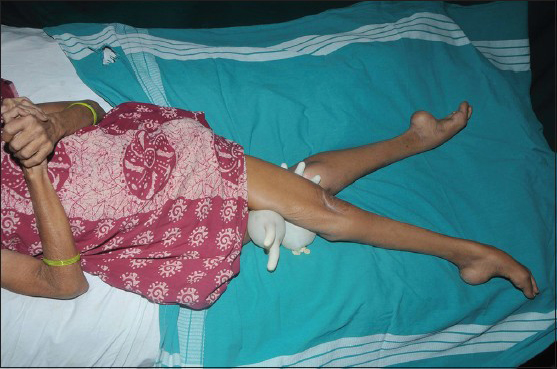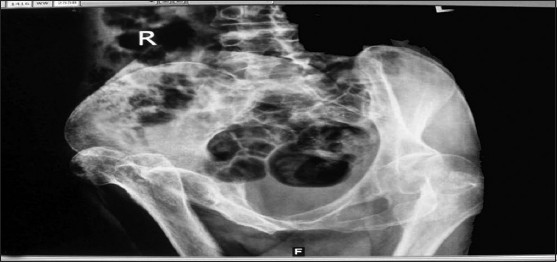Translate this page into:
Battered woman syndrome: An unusual presentation of pseudodystonia
This is an open-access article distributed under the terms of the Creative Commons Attribution-Noncommercial-Share Alike 3.0 Unported, which permits unrestricted use, distribution, and reproduction in any medium, provided the original work is properly cited.
This article was originally published by Medknow Publications & Media Pvt Ltd and was migrated to Scientific Scholar after the change of Publisher.
Abstract
Pseudodystonia is the term used to define abnormal postures, which are not due to the disorders of the basal ganglia and is encountered very rarely in clinical practice and often difficult to distinguish from true dystonia syndromes. We report a rare case of a battered woman who was managed as restricted resistant dystonia with pharmacotherapy and intrathecal baclofen and referred for considering deep brain stimulation (DBS). The patient turned out to be a case of pseudodystonia due to bilateral hip dislocation. This was due to assault by a close relative and the history was masked by the patient for more than one and a half years. In a patient with late onset dystonia, who is resistant to the recommended treatment for dystonia along with atypical clinical features and electrophysiological parameters, pseudodystonia should always be considered as a possible diagnosis and evaluated for causes of the same.
Keywords
Deep brain stimulation
dystonia
pseudodystonia
Introduction
Pseudodystonia is the term used to define abnormal postures, which are not due to the disorders of the basal ganglia and is encountered very rarely in clinical practice and often difficult to distinguish from true dystonia syndromes.
Case Report
We report a rare case of a battered woman who was managed as restricted resistant dystonia with pharmacotherapy and intrathecal baclofen and referred for considering deep brain stimulation (DBS). The patient turned out to be a case of pseudodystonia due to bilateral hip dislocation. This was due to assault by a close relative and the history was masked by the patient for more than one and a half years.
Discussion
In a patient with late onset dystonia, who is resistant to the recommended treatment for dystonia along with atypical clinical features and electrophysiological parameters, pseudodystonia should always be considered as a possible diagnosis and evaluated for causes of the same. We report a rare case of a battered woman who was misdiagnosed as a case of dystonia and treated with all measures including intrathecal Baclofen pump. When nothing worked, she was referred to our institute.
Pseudodystonia is the term used to define abnormal postures, which are not due to the disorders of the basal ganglia. The conditions considered under this title are cranio-vertebral junction disorders, stiff person syndrome, contractures complicating muscle disease, torticollis due to ocular, vestibular, vascular, ligamentous causes, gastroesophageal reflux, arthritis, etc., and psychogenic dystonia.[12] But pseudodystonia due to traumatic bilateral hip dislocation is not reported in the literature so far to our knowledge.
A 60-year-old middle class female, from Andhra Pradesh, south India, was referred as a case of resistant dystonia with a note to consider deep brain stimulation (DBS) from a tertiary level centre.[3] She was suffering from abnormal posturing of both lower limbs of one and a half years duration. The history was vague and inconsistent. Sudden onset abnormal posturing of both lower limbs, which is non-progressive, was reported. They denied any precipitating preceding events including use of drugs or trauma. There was no family history. There is no involvement of bladder, bowel sensations, or upper limbs. Clinical examination showed a malnourished alert woman. She had no cataract or KF ring. General examination and examination of other systems were noncontributory. Her higher mental functions, cranial nerves and upper limbs were normal. Examination of lower limbs showed the following: There was complete crossing over of one leg over the other. The left leg was completely toward the right and her left patella was facing towards the left and ankle was plantar flexed with tendoachilles contracture. The right leg was towards the left and right patella was posterior. Ankle was plantar flexed with tendoachilles contracture [Figure 1]. There was a palpable tender bony swelling over both hips. The muscle power could not be tested. On palpation, muscles were flabby and thin. Any attempt to move the legs was restricted by severe pain.

- The left lower limb axially rotated, patella facing left and limb displaced to right. The right lower limb displaced to the left and patella is posterior
She was investigated in the referring hospital for Wilson's disease and neurodegenerative diseases. Her magnetic resonance imaging (MRI) brain and spine were normal. She was treated with Trihexyphenidyl, muscle relaxants, dopaminergic drugs, and intrathecal baclofen.
On arrival to our hospital we performed Electromyography studies which was normal in all four limbs and X-ray pelvis was done. It showed complete dislocation and displacement of right hip so that the head of the femur was externally rotated and facing rightwards. There was partial dislocation on the left side [Figure 2] (Right head of the femur is facing outwards and left head of the femur partially displaced towards the left).

- Right head of the femur is facing outwards and left head of the femur partially displaced toward the left
There were no fractures. A diagnosis of pseudodystonia due to bilateral dislocation of the hip was made. History was reassessed ensuring that no legal formalities will be initiated. Then they confessed that the patient was pulled forcefully by both legs, twisted and thrown out by a close relative. As per the recommendation of the orthopedic surgeon, reduction under GA and pelvis binding was performed and the patient is recovering. The dystonia at both ankles and distal foot could be due to complex regional pain syndrome and both dystonia and pain recovered after reduction and treatment.
When there is sudden onset of a segmental fixed posture seen with normal muscle tone and EMG, along with painful restriction of movement, a high degree of suspicion should be maintained to look for causes of pseudodystonia as it will have a great role in diagnosis and management of this entity.
Source of Support: Nil.
Conflict of Interest: None declared.
References
- Psychogenic Dystonia. In: Fahn S, Jancovic J, eds. Movement Disorders. Elsevier Publications; 2007. p. :319-20.
- [Google Scholar]
- Dystonic Disorders, chapter 25. In: Tolosa E, Jancovic J, eds. Parkinsons Disease and Movement Disorders (5th edition). Lippincott Williams and Wilkins; 1998. p. :322-43.
- [Google Scholar]
- Five-year follow-up of 10 patients treated with globus pallidus internus deep brain stimulation for segmental or multisegmental dystonia. Stereotact Funct Neurosurg. 2012;90:84-91.
- [Google Scholar]






